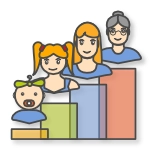Career Theory – Categories
On this page:
Career theories can be divided up in different categories or families. Although these are not strict and some theories belong to more than one, there is usually one dominant ‘genetic’ strand within them. The main families or categories on this page are:
For information linked to individual theorists and theories, the next page contains a timeline from where you can easily link through. But, let’s have a look to see what they have in common, what the differences are and who the main theorists are:
 Differentialism
Differentialism
Square pegs in square holes…
How are career decisions reached/planning achieved?
Clients are measured in a scientific way, through psychometric testing or other online tests, and by then matching their characteristics with those required for a particular career. Modern examples are the Morrisby test and Kudos, but also Start profile.
Central idea – original
Differentialism in the context of career guidance doesn’t have anything to do with how cultural differentialism is understood now, as a movement to protect differences between people(s) with different cultural heritage (Guido Bolaffi et al. Ed.. 2003). Within career guidance, it’s related to how individuals differ and how these difference can be measured in a positivistic or scientific way. An individual’s characteristics are deemed to be intrinsic to that person and unchangeable. Apart from environmental theory, another alternative term for Differentialism is trait and factor, which should make its central idea clearer.
How is it relevant now?
Today’s theorists and professionals have criticised differentialism for being too right and for seeing personal traits as fixed, while at the same time not recognising the flexibility and varied nature of the job market and individual careers. Differentialism is still very influential because it can offer an easy, quick and arguably cost-effective way into career planning and career decision making. However, trait and factor techniques by themselves are not regarded as enough anymore as the sole principle of career guidance or the sole tool in career interventions. It’s used in combination with other theories, models and techniques.
Theorists
- Frank Parsons 1910
- Myers Briggs – Type indicator model 1944
- Raymond Cattell – 16PF questionnaire 1946
- Alec Rodger – 7 point plan 1952
- Ernest Tupes and Raymond Crystal – 5 factor model 1961
- John Holland – 5 personalities 1966
- Dawis and Lofquist – Work Adjustment Theory 1984
Tools
Led to development of range of psychometric tests, interest profiles and skills inventories – examples are Kudos, Fast Tomato, Meyers-Briggs, etc…
Critique – some ideas
Some of the crucial points levied at differentialism can be:
- Positive:
- Can look measurable and cost effective
- Can be easy and quick
- It’s a good starting point and can be reassuring for the client
- The different qualities discovered can be used for job applications
- Easy way into decision making
- Critique:
- The world of work as well as individuals are more complicated
- People and the world around us is not static
- Can be regarded as the be all and end all of career guidance, which can be damaging for the client
- Can undervalue intuition and may other factors that are important in career decision making (transport, availability of jobs, financial implications…)
- Doesn’t take into account other social, cultural and familial influences
![]() Can you think of any critique, positive or negative, yourself? How could differentialism help or hinder your practice? What are the positive outcomes it can generate and where can it be difficult or dangerous, for you or the client, to use Differentialist techniques and thinking?
Can you think of any critique, positive or negative, yourself? How could differentialism help or hinder your practice? What are the positive outcomes it can generate and where can it be difficult or dangerous, for you or the client, to use Differentialist techniques and thinking?
References
- Guido Bolaffi et al. Ed (2003), Dictionary of Race, Ethnicity and Culture, Sage Publications
- Taylor, Frederick Winslow (1911), The Principles of Scientific Management, New York, NY, USA and London, UK: Harper & Brothers
Videos
- Recommended: https://youtu.be/TPef1U0863E?si=bBIAl_3Xk7h7Ir4I
 Developmentalism
Developmentalism
We go through stages of change as we grow older
How are career decisions reached/planning achieved? And what is its central idea?
Central idea or premise – people develop in stages over time Super, one of the main theorists in this category of career guidance theories, developed the ‘Careers Rainbow’* which looks at the different stages people move through in life and how their self-concept changes throughout. As opposed to differentialism, developmental theorists will argue career development isn’t static but moves through different stages as people move through life. People make career decisions that will fulfil and be related to their self-concept at each and every stage of their life. Career decisions are therefore not a one time decision and career ideas change throughout life, as people move through the different stages. Career decisions will also become more mature and stable as people grow older.
How is it relevant now?
We can all recognise that we change throughout life and maybe even that we go through different stages. Developmentalism, when it comes to a staged model, has lost some of its direct relevance and lustre in the 21st century however, in that the ‘world out there’ and the ‘world of work’ are much more fragmented and prompt a less rigid and structured flow of change through life. Sometimes, the reality around individuals changes and we find ourselves not fitting in with that new reality as we are. This doesn’t mean that we can necessarily move on to the next state in our life, as the stages are linked to age, but that we may need to take a (partial) step back to a previous stage to reconsider and mature again into that new reality. Some theorists have recognised the rigidity of their theory and added to, or adapted it to reflect the modern age.
Theorists
- Eli Ginzberg – Developmental Theory 1951
- Donald Super – Developmental Theory and Life Span Learning 1957 & 1961; further developed in 1980
- Linda Gottfredson – Theory of Circumscription and Compromise 1981
Tools and Consequences for career guidance practice
As mentioned already, Super developed his Careers Rainbow, which can be used as a tool with clients but also as a reference for professionals. Career guidance needs to be on offer as an all age service, rather than just at the development stage (as differentialism would suggest is enough), including at different stages during childhood and adolescence, to give the career professional the chance to assess a client’s planning and its relationship to the different stage they are in, in their life. There are no specific tools developed around this theory in the same sense as there are for differentialism, as far as I know, but developmental work will depend on the theorist you want to apply the theory of. It will invariable include:
- an assessment of where a client is, what life stage they are at,
- and how their planning is influenced by, amongst other things, their level of career maturity, including skills, ideas, preferences and their awareness about self – their self-concept.
The aim for the career professional is to support clients to develop vocational maturity – to become more self aware and identify where they fit in, in the world of work, in relation to the stage of life they are at.
Critique
- I would argue that developmentalism is reflective of a time when jobs were more stable and allowed a linear ‘career flow’ through life.
- Earlier developmental models in particular can be seen as too focused on individual development and not taking account of external factors.
- At the same time, it broadly relates well to many people’s experience of moving through life in more or less set stages and it offers a model for ongoing, all-age career guidance, such as the career guidance model in Scotland.
![]() Questions to ask yourself in view of this theory could be:
Questions to ask yourself in view of this theory could be:
- Do we really flow through more or less fixed stages throughout our life? If, so, do the different theories reflect these well? And if not, why not? What stops us from moving through the different stages as proposed?
- Do the stages we move through in our life appear to be ‘naturally driven’? Or are there other influences at play as well? And if so, which ones and how to they impact on us and the decisions we make?
- Is developmentalism and the theories of the main proponents too fixed or too fluid, relative to your experience in your own life?
- Does 21st century society allow for those stages? Or does present day reality contradict those?
- How does developmentalism relate to the model of career guidance in England?
*See the relevant webpage on Super on this website.
Videos
- Recommended: https://youtu.be/8_xlDOyKPqc
 Structuralism
Structuralism
We are what society allows us to be
Opportunity structure rather than occupational choice. In this case, the iconography I decided to use to represent and help you understand and remember structuralism is only partially right. Structuralism is traditionally trying to explain how the different structures in society influence or even determine the choices we make and the opportunities we have.
However, in the 21st century, it’s also about how we respond to these determinants and how we break free from them by being aware of the structures and influences in our life. The ongoing validity or how a theory needs to change, if it’s been conceived a long time ago, is an issue to consider with every theory you encounter or use for your assignment, but especially so with structuralism.
Premise:
- structuralism stresses the influence of our environment in the broadest sense on career choice – class background, state of labour market, ethnicity, gender, etc… Access to employment is often determined by others – it’s not simply our own choice. Our own upbringing can also influence where we think we ‘fit’ in the labour market.
Implications:
Within the structuralist paradigm, the scope of careers guidance was initially seen as limited – guidance more about adjusting a person to the realties surrounding them. Career guidance took on the character of a job placement service. Because of it’s controversial nature, which affects us at the core of who we feel we are (our own free will) it’s important to consider this theory a bit further.
![]()
- Ask yourself whether this still applies?
- Can you think of examples in your own life where you recognised influences that weren’t your own pulling the strings?
- And what approach can you take with clients, within the context of this theory?
Generally, the approach advisers often take is that the job market is much more fluid now, and there is much more mobility. Within this, there are tools we can use: eg.: challenging and open questioning.
Examples could be:
- Making clients aware of the implications of social structures – making them aware of how this could impact on their career planning now and in the future.
- Challenge clients on perceived limitations or opportunities relative to society’s structures.
Videos
- Recommended: https://youtu.be/1WzBHSfXHqc
 Social Learning
Social Learning
We are what we learn
Social learning theory looks at how people view the same experience differently.
- Premise: learning takes place through observations & direct experiences.
- Individual learning experiences over a person’s life time are primary influences that lead to career choice.
- Approach: providing career-relevant experiences and motivating clients to initiate exploratory activities
Tools to help the career guidance professional achieve this with the client include:
- Helping the client to learn a rational sequence of decision-making skills through investigative questioning, prioritising, story building, etc…
- Arrange an appropriate sequence of career-relevant exploratory experiences
- Evaluate the personal consequences of those experiences through open questioning
A possible approach an adviser could take to work with this is to exploit the client’s ability to learn through observation, imitation and role modelling.
Videos:
- Recommended: https://youtu.be/ohDlAePs7uU
 Happenstance Theory
Happenstance Theory
Things happen, and we adapt and grab opportunities
In the context of social learning theory and in relation to the requirements for the level 6 qualification in career guidance and development, this deserves a special mention. This category includes Planned Happenstance Theory and also the Chaos Theory of Careers.
Premise:
Many start a career through chance rather than a rational approach
Approach:
We need to try and prepare ourselves (and our clients) for unplanned events – maximising opportunities. We also need to seek out, and open ourselves up for those events and respond to them positively. This requires a different skills set, which you will notice is more or less the opposite to structuralism and differentialism but the tools of which we can still use in our work with clients.
How can we use this in practice?
Differentialist tools can offer a first step, especially for young people, if used with awareness of its limitations and with caution and care.
- Advisers can use the following tools to work with happenstance theory: e.g.:
 Constructivism
Constructivism
We write our own story
Constructivism starts with the premise that we all form our own views of the world and this governs our thinking and decision making, including what we decid to do for a career or job. Constructivists also argue that:
- The process of careers decision making cannot be simply explained
- The approach they take is that the key for the adviser is to understand each individual’s narrative constructs – the stories that they tell about themselves about who they are, what is important and how they form their stories (influences and role models for instance)
- Tools used to achieve this will be scripted questions to make sure the client understands what the career professional is looking for.
This theory has moved as far away as possible from differentialism with its fixed, positivist world view and its mechanistic methods. Constructivism describes a world without right or wrong answers – just different views! Relativism is key in this approach. What this means for career guidance is that an approach is taken that entirely concentrates on the client and only indirectly takes into account other actors and factors that either limit or enable options or that influences the thinking of the client.
Videos
- Recommended: https://youtu.be/neQqmTk0_3E
 Holistic Career Theories
Holistic Career Theories
If you do what fulfils you, you never work a day in your life – 360º career planning.
How are career decisions reached/planning achieved?
There are generally two parameters we can recognise in holistic working: A vertical aspect that aims to go deeper than the individual issues of other, older theoretical frameworks:
- Holistic career practice aims to explore the whole person and the career practitioner then looks for a combination of theoretical concepts and practical techniques in order to support the client.
A horizontal aspect that not only looks at how the client fits in with the working/social/political, etc… environment, but also all the other aspects of their life and environment and how they can acquire lifelong planning, decision making and problem solving strategies and techniques. Just like happenstance, lifelong opportunities for forced or voluntary change are important, but also, just like constructivism, the client’s life history and their own set of constructs as well as their socio/cultural environment and possibilities.
Theorists
Some examples of Holistic Theorists/Theories are:
- Arthur and Rousseau – Boundaryless Career 1996
- Hansen – Integrative Life Planning 1997
- Krumboltz – Happenstance Theory 1999
- Miller – Tiedeman – Life-Is-Career Theory 1999
- Rivern – Simard – Continuous Participation Model 2005
- Pryor and Bright – Chaos Theory of Careers 2011
Critique
![]() You could ask yourself the following questions:
You could ask yourself the following questions:
- Is a truly holistic approach possible in the career guidance environment of today?
- In spite of claiming to cover ‘all angles’, is holistic theory missing out on certain aspects important in career decision making? (you could consider unconscious bias, the effect of lack of effective communication with a client, partly inherent in the language we use, etc…)
- How can we work with a theory like this as practitioners? Isn’t it too overwhelming, especially for those starting out in career guidance? If not, why not?
- Is it the best approach under all circumstances?
- What could be the positive side to applying holistic practice to career guidance for you?
- What knowledge, skills, insight and awareness is required in holistic practice – would you be able to acquire what is needed?
- Holistic practice suggests lifelong development and learning – how does that work for us as practitioners? Paradox or supportive idea?
Some tips for your research:
Normally, none of us have access to a full academic library. The best most of us can hope for is a search on the web and the few books we have. Making your time on the web count is important and I hope the following will help with that:
- If you are exploring a new to you theory, I would suggest starting with a picture search in google or similar. This will normally bring up a visual representation of the theory you are exploring. But… be careful you have the right one! This will hopefully give you a quick and easy way into a new theory.
- Wikipedia, however imprecise it is by reputation, is a good starting point to get to know more about theorists. Also don’t forget the references at the bottom of every Wikipedia page, which can offer an excellent reading list for further exploration.
- By adding the word ‘scholar’ or ‘academic’ behind your search term, you may have access to one of the many extracts of research texts that are available online. Another possible source of references, information and research could be book previews on websites like Amazon and co.
- I have also added some useful links to websites about career theory in the ‘useful links’ section of this part of the website.
